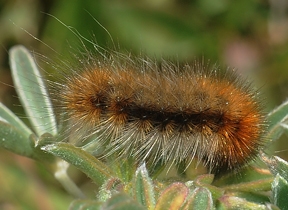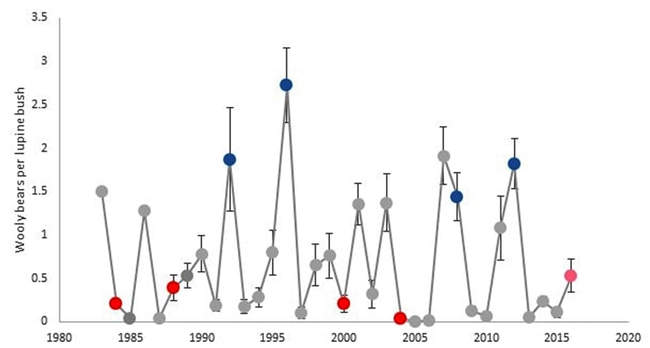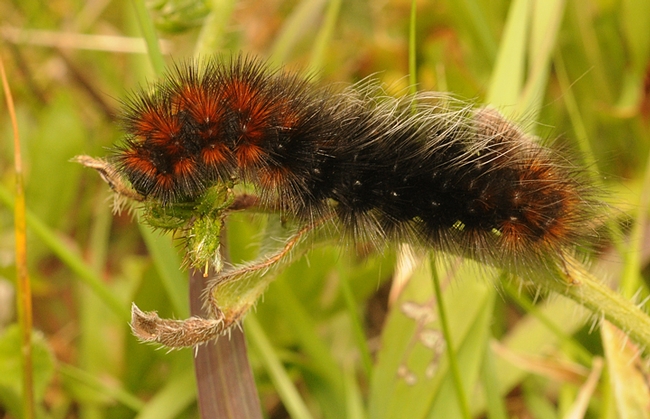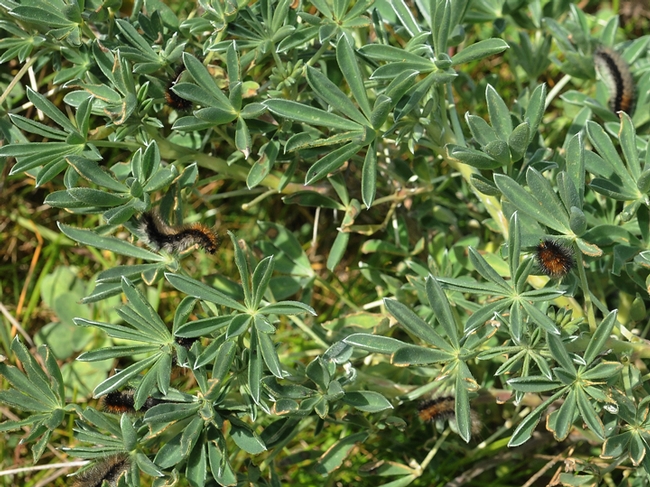
For the past three decades, woolly bear caterpillars have accurately predicted a Republican or Democrat win in the U.S. Presidential elections.
This year, despite the pollsters, pundits and political fervor, the woollies again successfully predicted the outcome.
Just as noted UC Davis ecologist Richard “Rick” Karban and his lab prognosticated.
Karban and his fifth-year doctoral student, Eric LoPresti, study the woolly bear caterpillars, which populate the cliffs of the Bodega Marine Reserve, above the Bodega Marine Laboratory, Sonoma County. The fuzzy reddish-black caterpillars, which feed primarily on lupine, are the immature form of the Ranchman's Tiger Moth, Platyprepia virginalis.
Sometimes the population booms; other times, it's a bust, said Karban, a professor in the UC Davis Department of Entomology and Nematology and a fellow of the American Association for the Advancement of Science. In their 30-year census of the same lupine patch, they noticed that when the population thrives, a Democrat heads to the White House. When the population dives, the Republicans take over.
And why not? “Paul the Octopus had a pretty good run predicting soccer matches in 2012, so perhaps the woolly bears have earned as much credibility at forecasting this presidential election,” Karban said last May.
Although most polls forecast a Democratic win, the UC Davis Woolly Bear Presidential Election Outlook did not.
However, they are not all that pleased with the outcome. “We're kind of bummed,” Karban said. “We didn't want to believe that the woolly bears were predicting a red outcome.”
The scientists, who study insect-plant interactions, first announced their presidential outcome predictions in a poster displayed at the 2014 Ecology Society of America meeting, held in Sacramento. Then this year, on April 25, they expanded on the concept, complete with intricate charts plotted in red and blue, in LoPresti's Natural Musings blog, “The Woolly Bear Presidential Election Outlook 2016,” co-written by scientists in the Karban lab.
“Each March, Karban censuses the same patches of lupine that he has for over 30 years,” LoPresti explained in Natural Musings. “The study asks a vexing question: Why are there are so many caterpillars in some years and so few in others? Many insects, including pests cycle like this, therefore it is of keen interest to many. Dozens of papers later, Karban, his students, and his collaborators have answered a great many questions, including how caterpillars deal with parasites, whether population cycles are influenced by rain, whether caterpillars enjoy eating plant hairs, and how caterpillars avoid their predators.”
The woolly bears, as presidential forecasters, drew national attention. Washington Post reporter Karin Bruilliard ran with it in a piece published April 26: “These Fuzzy Little Caterpillars Are Better at Predicting Elections Than Most Pundits.”
“Who's going to win the presidential election?” Bruilliard asked. “Heck if we know. Try to answer that question without a crystal ball and you'll run head-on into a dizzying array of national polls and state polls, fundraising tables and delegate counts, endorsements and prediction markets.”
LoPresti posted in his Natural Musings blog on April 25 that the woollies “seem to be leaning Republican.”
“Given their (pollsters') wildly erroneous predictions thus far for both primaries, trusting their predictions for the general election seems ill-advised,” LoPresti wrote. “The woolly bears, on the other hand, have a 100% accurate prediction record over the past 30 years. In years of low abundance, a Republican is elected, and in years of high abundance, a Democrat.”
“A superficial examination suggests that 2016 will be a Republican year – woolly bear abundance is not particularly high,” LoPresti noted. “However, looking a little closer, it may not be. The number of woolly bears per lupine bush in 2016 (0.53) is higher than the average Republican year by 152% and is 36% above the highest Republican year ever recorded (1988). However, it is only 27% of an average Democratic year and still only 36% of the lowest Democratic year (2008). This result is without presidential precedent in the last 30 years.”
What about the next presidential election, now that Vice President Joe Biden has indicated he might run?
“The woolly bears have not weighed in on Joe Biden,” Karban said.
Karban, internationally known for his work on plant communication, is the author of the book, Plant Sensing and Communication (University of Chicago Press), hailed as a landmark in its field. He has researched plant communication in sagebrush (Artemisia tridentata) on the east side of the Sierra since 1995.
Plants can eavesdrop, sense danger in the environment, and can distinguish friend from foe, Karban says. A plant under a predatory attack will emit volatile chemical cues, enabling its neighboring plants to adjust their defenses to better protect themselves.
Karban is featured in the Dec. 23-30, 2013 edition of The New Yorker in Michael Pollan's piece, “The Intelligent Plant: Scientists Debate a New Way of Understanding Plants."
Attached Images:

UC Davis researchers Rick Karban (left) and his graduate student Eric LoPresti with their chart linking woolly bear caterpillars to U.S. Presidential elections. (Photo by Kathy Keatley Garvey)

Close-up of U.S. Presidential election predictions (red designates Republicans and blue, Democrats).

A woolly bear caterpillar on Bodega Head in 2011. (Photo by Kathy Keatley Garvey)

Woolly bear caterpillars eating lupine in 2008 on Bodega Head, Sonoma County. (Photo by Kathy Keatley Garvey)